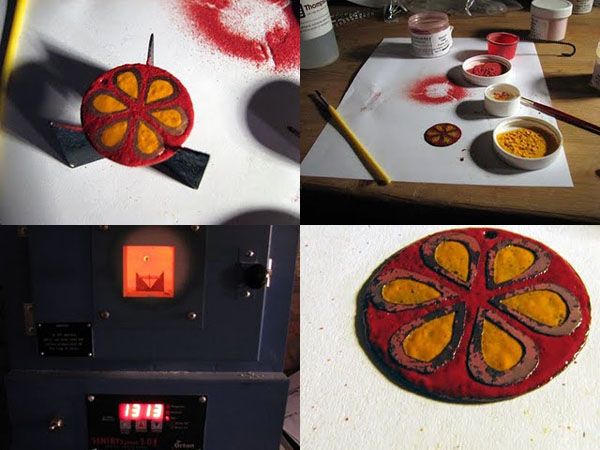ENAMELING UP CLOSE // Learn to Make Sgraffito and Plique-à-jour Jewelry This Summer
 Jun 3, 2011 Tweet
Jun 3, 2011 Tweet  Previously, we took a look at the magic behind champlevé and cloisonné, jewelry-making techniques that you can learn in our Enameling 2 class. Now we'll round out our series with the class' other two processes, sgraffito and plique-à-jour.
Previously, we took a look at the magic behind champlevé and cloisonné, jewelry-making techniques that you can learn in our Enameling 2 class. Now we'll round out our series with the class' other two processes, sgraffito and plique-à-jour.
Sgraffito is an approach that also exists in painting, drawing and decor (it was particularly popular in the Art Nouveau movement), but with enameling it involves applying and firing a base coat of enamel on a piece, followed by a thin layer of sifted, powdery enamel of a different color. The top layer is then scratched off in the desired shape or pattern, revealing the base coat. Another firing in the kiln preserves it. To the right you can see a matching necklace and earrings made with sgraffito enameling by Kira Scott. For more on sgraffito (which is derived from the same Italian word as graffiti—graffiare, "to scratch"), check out this tutorial.
Plique-à-jour (French for "open to light") is the technique of creating different sections of translucent enamel that are divided and supported by a metal framework. Think stained glass, but with enamel and metal rather than glass and lead. It's also similar to cloisonné, but without a base surface supporting the enamel. For an idea of what plique-à-jour pieces look like take a look at some images on Flickr.
OK, enough explaining! Just sign up for Enameling 2 this summer and make your own sgraffito and plique-à-jour jewelry!
--John Ruscher
 Email tagged
Email tagged  Enameling Up Close
Enameling Up Close 


